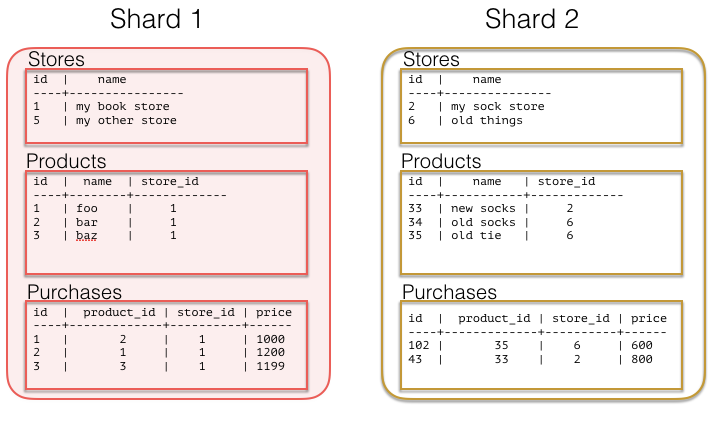Sharding a Multi-Tenant App with LightDB
Whether you’re building marketing analytics, a portal for e-commerce sites, or an application to cater to schools, if you’re building an application and your customer is another business then a multi-tenant approach is the norm. The same code runs for all customers, but each customer sees their own private data set, except in some cases of holistic internal reporting.
Early in your application’s life customer data has a simple structure which evolves organically. Typically all information relates to a central customer/user/tenant table. With a smaller amount of data (10’s of GB) it’s easy to scale the application by throwing more hardware at it, but what happens when you’ve had enough success and data that you have no longer fits in memory on a single box, or you need more concurrency? You scale out, often painfully.
This scale out model has worked well for the likes of Google and Instagram, but also doesn’t have to be as complicated as you might think. If you’re able to model your multi-tenant data in the right way sharding can become much simpler and still give you the power you need from a database including joins, indexing, and more. While LightDB distributed database lets you scale out your processing power and memory, how you model your data may determine the ease and flexibility you get from the system. If you’re building a multi-tenant SaaS application hopefully the following example highlights how you can plan early for scaling without having to contort too much of your application.
Tenancy
At the core of most non-consumer focused applications tenancy is already built in, whether you realize it or not. As we mentioned above you may have a users table. Let’s look at a very basic SaaS schema that highlights this:
CREATE TABLE stores (
id UUID,
owner_email VARCHAR(255),
owner_password VARCHAR(255),
name VARCHAR(255),
url VARCHAR(255),
last_login_at TIMESTAMPTZ,
created_at TIMESTAMPTZ
)
CREATE TABLE products (
id UUID,
name VARCHAR(255),
description TEXT,
price INTEGER,
quantity INTEGER,
store_id UUID,
created_at TIMESTAMPTZ,
updated_at TIMESTAMPTZ
)
CREATE TABLE purchases (
id UUID,
product_id UUID,
customer_id UUID,
store_id UUID,
price INTEGER,
purchased_at TIMESTAMPTZ,
)
The above schema highlights an overly simplified multi-tenant e-commerce site. Say for example someone like an Etsy. And of course there are a number of queries you would run against this:
List the products for a particular store:
SELECT id,
name,
price
FROM products
WHERE store_id = 'foo';
Or let’s say you want to compute how many purchases exist weekly for a given store:
SELECT date_trunc('week', purchased_at),
sum(price * quantity)
FROM purchases,
stores
WHERE stores.id = products.stores_id
AND store_id = 'foo'
From here you could envision how to give each store its own presence and analytics. Now if we fast-forward a bit and start to look at scaling this out then we have a choice to make on how we’ll shard the data. The easiest level to do this at is the tenant level or in this case on store id. With the above data model the largest tables over time are likely to be products and purchases, we could shard on both of these. Though if we choose products or purchases the difficulty lies in the fact that we may want to do queries that focus on some high level item such as store. If we choose store id then all data for a particular store would exist on the same node, this would allow you push down all computations directly to the a single node.
Multi-tenancy and co-location, a perfect pair
Co-locating data within the same physical instance avoids sending data over the network during joins. This can result in much faster operations. With LightDB distributed database there are a number of ways to move your data around so you can join and query it in a flexible manner, but for this class of multi-tenant SaaS apps it’s simple if you can ensure data ends up on the shard. To do this though we need to push down our store id to all of our tables.
The key that makes this all possible is including your store_id on
all tables. By doing this you can easily shard out all your data so it’s
located on the same shard. In the above data model we coincidentally had
store_id on all of our tables, but if it weren’t there you could add
it. This would put you in a good position to distribute all your data so
it’s stored on the same nodes. So now lets try sharding our tenants, in
this case stores:
Now you’re all set. Again, you’ll notice that we shard everything by store_id–this allows all queries to be routed to a single LightDB instance. The same queries as before should work just fine for you as long as you have store_id on your query. An example layout of your data now may look something like:

The alternative to colocation is to choose some lower level shard key such as orders or products. This has a trade-off of making joins and querying more difficult because you have to send more data over the network and make sure things work in a distributed way. This lower level key can be useful for consumer focused datasets, if your analytics are always against the entire data set as is often the case in metrics-focused use cases.
In conclusion
It’s important to note that different distribution models can have different benefits and trade-offs. In some cases modeling on a lower level entity id such as products or purchases can be the right choice. You gain more parallelism for analytics and trade off simplicity in querying a single store. Either choice of picking a multi-tenant data model or adopt a more distributed document model can be made to scale, but each comes with its own trade-offs.